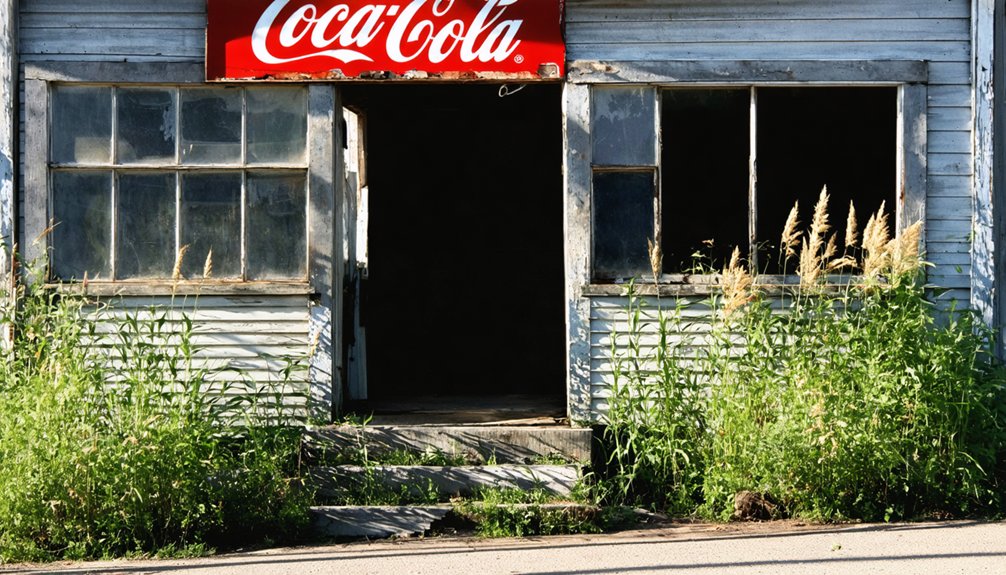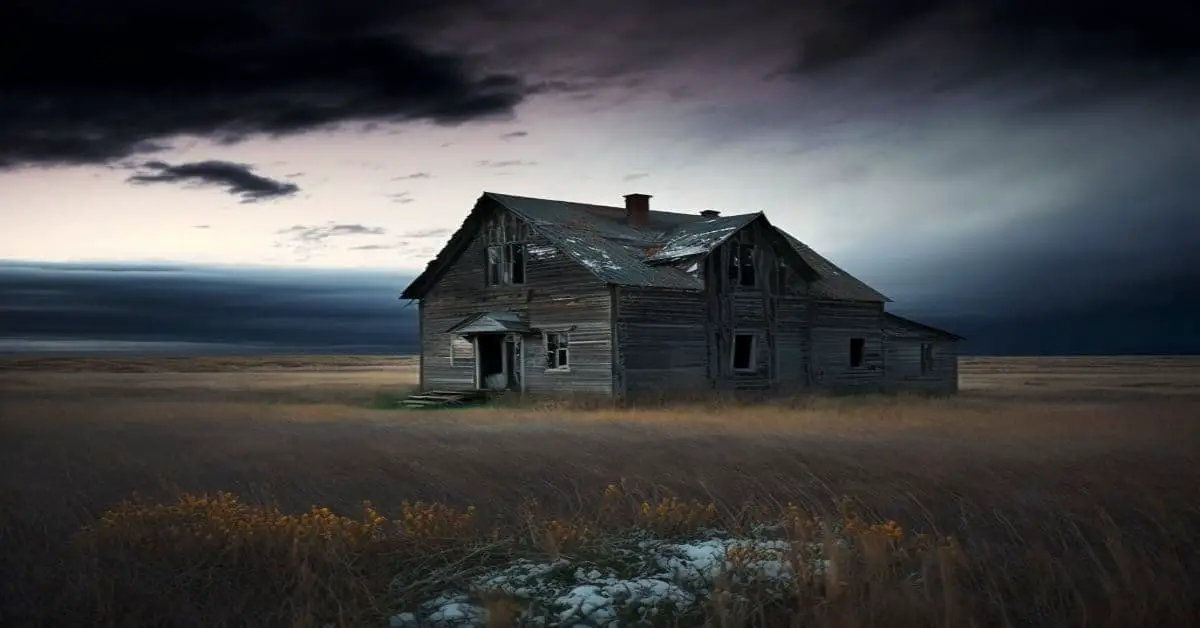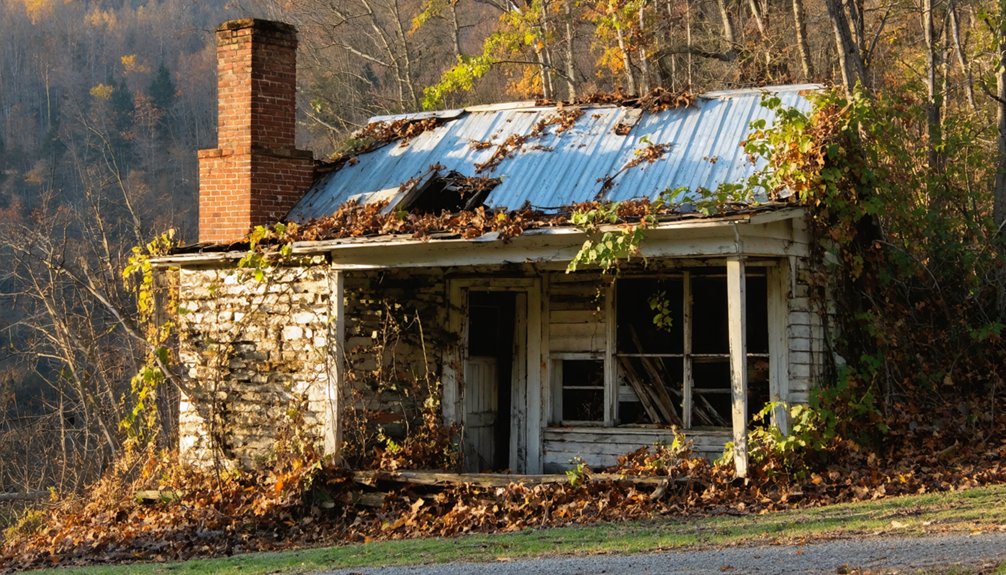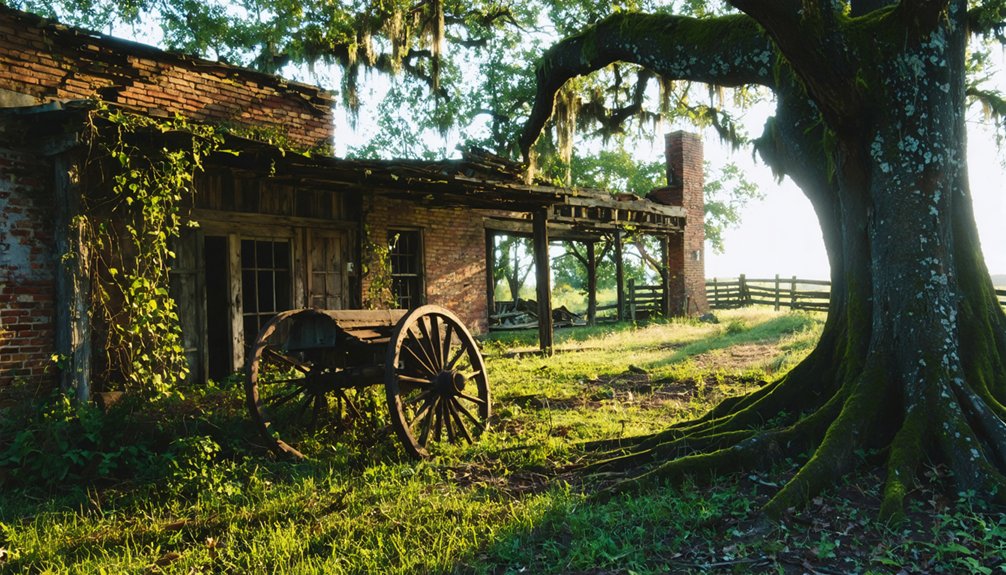You’ll find Bolding nestled in southern Union County, Arkansas, near Strong. This ghost town emerged in the early 1800s as a farming community, featuring fertile fields and pleasant country roads. The town flourished through agriculture and railroad commerce until mid-20th century mechanization and urbanization led to its decline. Today, scattered foundations and an old train depot mark where this once-vibrant community stood. Its quiet grounds hold fascinating stories of Arkansas’s rural heritage.
Key Takeaways
- Bolding was an agricultural community near Strong, Arkansas that declined due to economic shifts and rural migration in the mid-20th century.
- The town’s abandoned train depot remains a prominent landmark for ghost town explorers visiting the area today.
- Mechanization of farming and post-World War II urbanization led to population decline, eventually turning Bolding into a ghost town.
- Nature has reclaimed most of the original townsite, with scattered foundations and dilapidated structures amid mixed woodlands.
- Visitors can access the ghost town via country roads, but should prepare for minimal infrastructure and respect private property boundaries.
Location and Geographic Features
Situated in the southern reaches of Union County, Arkansas, Bolding stands as a tribute to the state’s rural heritage.
You’ll find this ghost town near Strong, Arkansas, surrounded by a landscape of flat to gently rolling farmland that speaks to the region’s agricultural roots. The area’s geographic accessibility relies on a network of pleasant country roads, all navigable by two-wheel drive vehicles.
Like many ghost town remnants across Arkansas, Bolding’s rural characteristics are evident in its scattered farms and homes, set against a backdrop of open fields and natural vegetation.
When you explore this quiet corner of Arkansas, you’ll experience the authentic charm of the region’s humid subtropical climate, where hot summers give way to occasionally snowy winters – an indication of the diverse weather patterns that have shaped this historic community.
The town’s Methodist church once served as a central gathering place for families and worshippers in the area.
Early Settlement History
You’ll find Bolding’s earliest roots in the fertile lands along the Black River, where John Ficklin established a settlement and ferry crossing around 1803.
Like many early Arkansas settlements, the area saw a mix of European settlers arriving in the 1820s from various states. The strategic location attracted agricultural pioneers like John A. Lindsey, who laid out the town on his farmland, while other settlers focused on farming, hunting, and operating river-based businesses. Similar to Hopefield’s Benjamin Foy, Lindsey became a prominent U.S. magistrate in the region.
The community, initially known as Powhatan, grew steadily as families built their homes and businesses near the ferry landing, taking advantage of both the river trade and rich farming opportunities.
Agricultural Roots Begin
The agricultural foundations of Bolding emerged through three distinct farming practices that defined early settlement life. You’d have found a diverse mix of crops, with corn leading the way alongside patches of wheat, oats, millet, and rye. Carroll and Boone Counties’ climate proved especially favorable for wheat production.
If you’d visited a typical hill farm, you’d have seen about 30 acres under cultivation, with 10 acres dedicated to corn and 5 to cotton. Large family units were crucial for managing these extensive farming operations. Local farmers relied on traditional harvesting methods, using sickles and grain cradles to work up to two acres daily. Many settlers, like James R. Bolding, operated blacksmith shops to maintain farming equipment.
They’d process their harvest on threshing floors, where horses helped separate wheat berries from stalks. Supporting these agricultural practices, local blacksmiths and tanners kept the community’s tools sharp and workhorses shod.
Settlement Location Origins
While records don’t pinpoint an exact founding date, Bolding emerged as a farming settlement in Union County, Arkansas during the late 19th or early 20th century.
You’ll find it nestled in the countryside near Strong, Arkansas, where early settlers carved out homesteads from the rural landscape. Today, only scattered farms and homes remain of the original settlement.
Like many ghost town settlements in Arkansas, Bolding lacks physical evidence of its original structures and layout.
The settlement naming followed a common Arkansas tradition, with Bolding likely taking its name from prominent local families who first established roots there.
Unlike some planned communities of the era, Bolding’s community dynamics developed organically, with scattered farms and homesteads spreading along country roads rather than following a formal town layout.
No evidence exists of earlier settlements at this location, making these Anglo-American farmers the first to establish permanent roots in this patch of Union County soil.
Early Resident Activities
Life in early Bolding centered around farming families who shaped their daily routines according to agricultural demands and seasonal rhythms.
Like Georgetown in 1789, the early settlement emerged as a close-knit farming community where residents adapted to frontier life.
As a farming community, you’d find residents working their lands, trading with neighbors, and maintaining essential farm equipment through manual labor and craftsmanship. The church stood as the heart of communal services, where you could join fellow settlers for worship and social gatherings that strengthened community bonds.
You’d notice the scattered homesteads connected by country roads, where families relied on each other and nearby towns like Strong for supplies and markets.
Small-scale local trade supported the agrarian economy, while craftwork and basic infrastructure maintenance kept the settlement functioning. The absence of formal institutions like schools meant that daily life revolved primarily around agricultural pursuits and church activities.
Life in Bolding’s Prime Years
During its prime years, Bolding existed as a close-knit rural community where scattered farms and country homes dotted the Union County landscape. You’d have found farming families living off the land, with daily life revolving around agricultural seasons and neighborly connections.
Community gatherings often centered around church functions and local markets, where residents would trade goods and share news. Like the residents of Rush Ghost Town, many relied on mining operations to supplement their agricultural income.
Beyond farming, you’d have encountered small-scale tradespeople and local services supporting the town’s basic needs. Rural traditions shaped the social fabric, with family gatherings and informal recreation bringing folks together.
While infrastructure remained modest, with dirt roads connecting homesteads and minimal utilities, the town’s spirit thrived through strong social bonds and shared agricultural lifestyles typical of Southern rural communities.
Agricultural Heritage and Economy
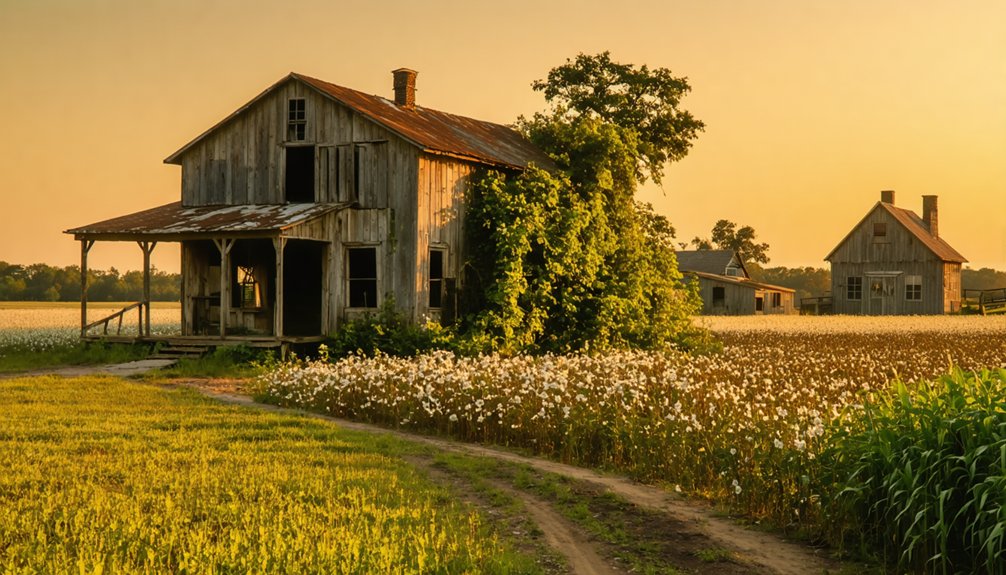
Cotton reigned supreme in Bolding’s agricultural landscape, where fertile Arkansas River Valley soils yielded bountiful harvests that shaped the town’s economic destiny.
You’d have found typical farms spanning 30 acres, where farmers practiced crop rotation between cotton, corn, and other sustaining crops. They’d complement their farming with hunting, fishing, and timber harvesting from the surrounding wilderness.
The region’s agricultural prowess wasn’t limited to cotton, though. Local farmers embraced sustainable farming methods, cultivating diverse crops while utilizing open ranges for livestock.
Despite cotton’s dominance, Bolding’s farmers practiced agricultural diversity, balancing crop cultivation with livestock grazing on open ranges.
As the century progressed, you’d have witnessed the transformation from manual labor to mechanization, while farm-related industries flourished. Cottonseed oil production, canning facilities, and timber processing emerged, creating a vibrant economic ecosystem that supported Bolding’s growth through the late 1800s.
The Gradual Decline
You’ll find Bolding’s decline followed a familiar pattern seen in many Arkansas ghost towns, where economic shifts and resource depletion gradually eroded the town’s liveliness.
The community’s younger residents increasingly sought opportunities in larger urban centers, while the closure of local businesses and services accelerated the exodus throughout the late 1800s.
Economic Forces Behind Change
The economic transformation of Bolding from boomtown to ghost town unfolded through a complex interplay of resource depletion and market forces.
You’ll find that zinc mining, which initially drove the town’s economic resilience, couldn’t sustain itself after World War I when demand plummeted and deposits dwindled. The town’s fate intertwined closely with the railroad’s presence, as transportation networks determined access to broader markets.
While some communities showed remarkable community adaptation by shifting to timber or agriculture, Bolding struggled to diversify.
The mechanization of farming and the shift to less labor-intensive livestock operations further accelerated the town’s decline. When the mines closed, businesses shuttered, and the male-dominated workforce dispersed, leaving behind empty buildings and fading dreams of prosperity.
Population Shifts Over Time
While historical records paint an incomplete picture of Bolding’s earliest days, it’s understood this Union County settlement flourished briefly as a farming community near Strong, Arkansas.
The population dynamics followed a pattern you’ll recognize from many rural Arkansas towns – a steady build-up during the agricultural boom, followed by a gradual emptying out.
You can trace the town’s decline to the mid-20th century when rural migration kicked into high gear. As farm mechanization reduced the need for manual labor, younger residents sought opportunities in urban areas.
The closure of local schools dealt a particularly harsh blow, removing a crucial community anchor. By the time post-World War II urbanization swept through Arkansas, Bolding’s fate was sealed, and its population dwindled until the town effectively vanished.
Present-Day Landscape
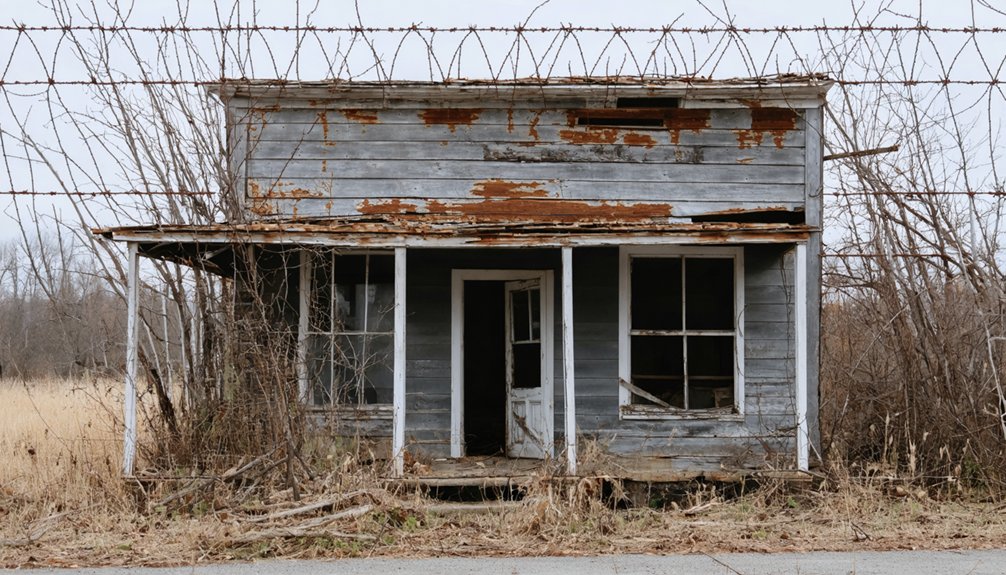
Scattered across Union County’s rural landscape, Bolding’s remnants paint a haunting picture of Arkansas’s railroad heritage.
You’ll find the old train depot standing as the most prominent landmark for ghost town explorers, while scattered foundations and dilapidated structures dot the quiet countryside. Nature has steadily reclaimed much of the land, with mixed woodlands and wild growth weaving between surviving ruins.
Today, you’re likely to encounter more wildlife than people as you explore these forgotten grounds. The surrounding farmland creates a patchwork of active agricultural plots interspersed with abandoned areas.
Nature and solitude reign where civilization once bustled, as wild creatures roam freely between working farms and forgotten spaces.
As you travel the peaceful country roads near Strong, Arkansas, you’ll discover how time has transformed this once-bustling railroad town into an atmospheric reflection of the region’s past, where silent ruins tell stories of earlier days.
Visiting the Former Town Site
Planning a visit to Bolding requires careful preparation and local knowledge, as this remote ghost town site offers minimal infrastructure for modern explorers. For a meaningful ghost town exploration experience, you’ll want to:
- Map your route using the coordinates (N33 05.198′, W92 13.920′) and verify access permissions before departure
- Pack essential navigation tools, as there’s no official signage marking the site
- Bring appropriate gear for backcountry conditions, including sturdy footwear and weather protection
- Document your findings, as the site’s historical significance remains largely unrecorded
- Respect any private property boundaries you encounter during your visit
While Bolding’s physical remains are uncertain, your visit helps preserve its memory as part of Arkansas’ pioneer heritage.
Remember to exercise caution and leave no trace of your exploration.
Local Stories and Memories
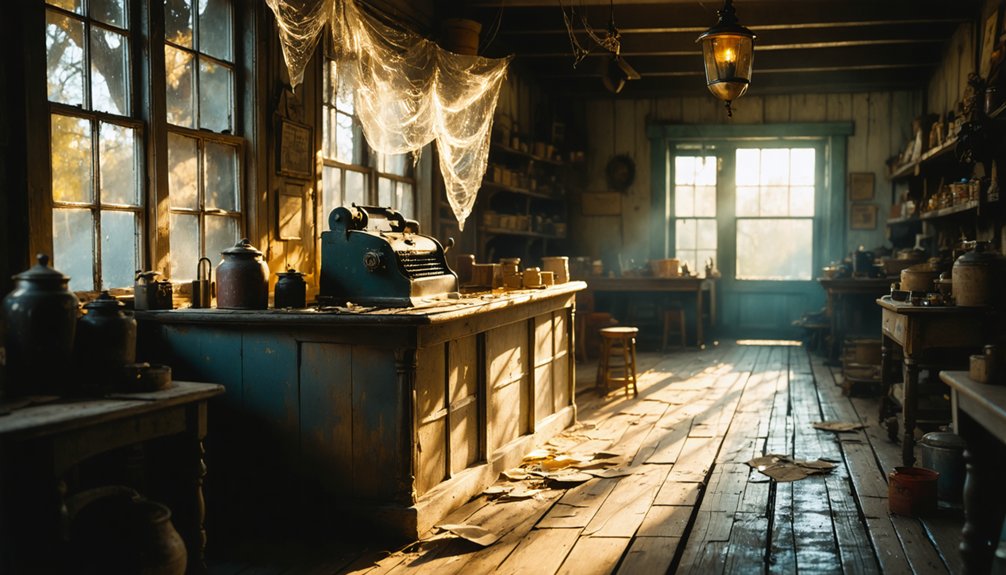
Through stories passed down by Union County residents, Bolding’s legacy lives on as a once-vibrant railroad community that time has nearly forgotten.
Local folklore paints a picture of bustling depot platforms where railroad workers and their families formed tight-knit bonds, sharing daily life around the hub of commerce and transportation.
Community tales often focus on the town’s dramatic transformation after the railroad’s realignment, as residents watched their livelihoods slip away with each passing train that no longer stopped.
You’ll hear whispers of unexplained phenomena around the old depot ruins, where some claim to sense echoes of the past.
These stories serve as powerful reminders of how quickly fortunes can change when economic foundations shift beneath a community’s feet.
Legacy in Union County
Today, Bolding’s enduring legacy in Union County extends far beyond its physical remains, serving as a poignant reminder of Arkansas’s dynamic railroad era.
You’ll find this ghost town significance woven into the fabric of local heritage, as it perfectly illustrates the railroad impact on rural communities. The town’s transformation from bustling railway stop to quiet remnant speaks volumes about economic shifts in southeastern Arkansas.
- Scattered depot ruins stand as silent sentinels to the bygone railroad days
- Historic maps reveal the ghostly outlines of former streets and homesteads
- Metal detectorists uncover tangible links to the past in abandoned fields
- Local tourism thrives as history buffs explore the forgotten railway stop
- Preservation efforts keep Bolding’s story alive for future generations
Frequently Asked Questions
Are There Any Surviving Photographs of Bolding During Its Populated Years?
You won’t find surviving photographs of populated years in historical archives, as there’s no confirmed photographic record available. Keep checking local collections though, as undiscovered artifacts sometimes surface.
What Was the Peak Population of Bolding Before It Declined?
While you’d be intrigued by Bolding’s historical significance, exact peak population figures weren’t documented before its decline. Based on mill employment and infrastructure descriptions, you can estimate several hundred to low thousands.
Were There Any Notable Crimes or Mysteries Associated With Bolding?
Despite searching through decades of historical records, you won’t find any documented unsolved cases or local legends from Bolding’s past – it was a peaceful rural settlement that faded quietly into history.
Did Any Famous or Historically Significant People Come From Bolding?
You won’t find any historically significant figures from this locale. While local legends might’ve existed within the community, no documented evidence suggests anyone from Bolding achieved widespread recognition or notoriety.
Are There Any Burial Grounds or Cemeteries Remaining in Bolding?
You won’t find marked burial sites or cemeteries in Bolding today – records and surveys show no evidence of cemetery history, and local research hasn’t uncovered any remaining gravesites in the area.
References
- https://www.onlyinyourstate.com/experiences/arkansas/ar-ghost-towns
- https://www.arkansas.com/articles/arkansas-urban-legends
- https://aymag.com/arkansas-backstories-ghost-towns/
- https://arkansasfrontier.com/ghost-towns-in-arkansas/303766/
- https://www.youtube.com/watch?v=s2a3hAf5d-Y
- http://freepages.rootsweb.com/~gtusa/history/usa/ar.htm
- https://en.wikipedia.org/wiki/List_of_ghost_towns_in_Arkansas
- https://www.youtube.com/watch?v=3oZuUMZk_Eo
- https://www.ghosttowns.com/states/ar/bolding.html
- https://www.ghosttowns.com/states/ar/ar.html
